Xylophanes titana
|
|
Updated as per
AN ANNOTATED CHECKLIST OF THE SPHINGIDAE OF BOLIVIA, October 2007
Updated as per http://www.pybio.org/SPHINGINAE.htm (Paraguay), October 2007
Updated as per More, Kitching and Cocucci's Hawkmoths of Argentina 2005, October, 2007
Updated as per personal communication with Ezequiel Bustos (Aguas Blancas, Salta, Argentina, 405m); December 2009
Updated as per personal communication with Larry Valentine (Itanhandu, Minas Gerais, Brazil, December 11, 2009); December 17, 2009
Updated as per personal communication with Brian Fletcher (Copalinga lodge, Podocarpus NP, Zamora-Chinchipe, Ecuador, February 5, 2014, 1100m); March 11, 2014
Updated as per personal communication with Sergio D. Ríos Díaz in CATÁLOGO DE LOS SPHINGIDAE (INSECTA: LEPIDOPTERA) DEPOSITADOS EN
EL MUSEO NACIONAL DE HISTORIA NATURAL DEL PARAGUAY; sent to me in July 2014 by Sergio D. Ríos Díaz.
Updated as per personal communication with Ezequiel Bustos (Shilap revta. lepid. 43 (172) diciembre, 2015, 615-631 eISSN 2340-4078 ISSN 0300-5267), January 4, 2016
Updated as per personal communication with Gernot Kunz (El Copan, Cartago, Costa Rica, March 6, 2019, 1047m); April 16, 2019
|
Xylophanes titana
zail-AH-fan-eesMtye-TAN-uh
(Druce, 1878) Choerocampa
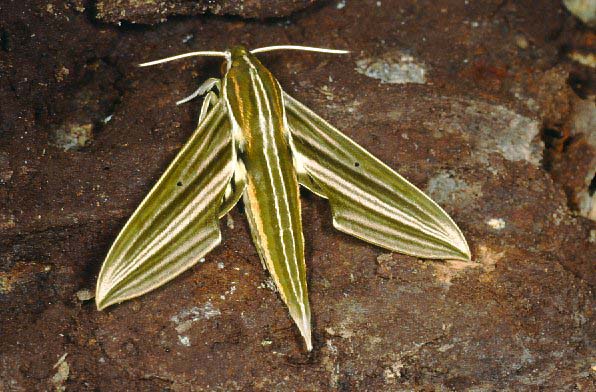
Xylophanes titana courtesy of Paolo Mazzei,
Rancho Grande, H. Pittier National Park, Venezuela.
This site has been created by Bill Oehlke.
Comments, suggestions and/or additional information are welcomed by Bill.
TAXONOMY:
Family: Sphingidae, Latreille, 1802
Subfamily: Macroglossinae, Harris, 1839
Tribe: Macroglossini, Harris, 1839
Genus: Xylophanes Hubner [1819] ...........
Species: titana Druce, 1878
|
MIDI MUSIC
.....It's a Wonderful World.....
copyright C. Odenkirk
ON.OFF
<bgsound src="world.mid" LOOP=FOREVER>
|
DISTRIBUTION:
Xylophanes titana moths
[wingspan 60-88 mm] fly in
Mexico;
Belize: Corozol, Cayo, Stan Creek, Toledo;
Guatemala: Izabal;
Honduras;
Nicaragua;
Costa Rica: Guanacaste; Cartago (GK);
Panama;
Colombia;
Ecuador: Zamora Chinchipe (BF);
Peru;
Bolivia:
Santa Cruz: Ichilo la Víbora; La Paz: Larecaja, Tipuani;
Paraguay: Canindeyu, Alto Parana, Cordillera, Central, Caaguazu, Paraguari, Guaira,
Caazapa (probably Itapua (WO??);
Argentina: Jujuy, Misiones, Salta (405m EB);
Venezuela;
French Guiana;
Brazil: Amapa, Amazonas, Rondonia,
Mato Grosso, Minas Gerais (LV), Rio de Janeiro, Sao Paulo, Parana, Santa Catarina;
and probably Guyana and
Suriname.
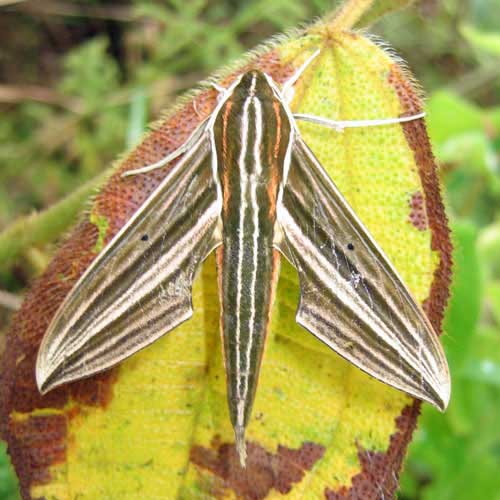
Xylophanes titana, Izabal, Guatemala, courtesy of Jose Monzon Sierra.
(Panama is the specimen type locality.).
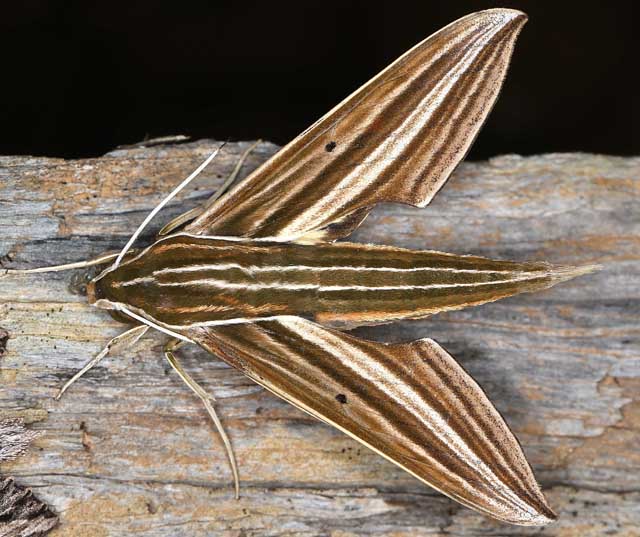
Xylophanes titana, El Copan, Cartago, Costa Rica,
March 6, 2019, 1047m, courtesy of Gernot Kunz.
The apex of the forewing
is distinctly pointed. Bands of dark and light brown colouration run
parallel to the costal margin of the forewing. The hindwing is black with
small triangles of yellow towards the trailing edge, a characteristic feature of the X. tersa group.
The abdomen has a distinct pair of stripes dorsally, which serve to separate X. titana from similar species.
The pronunciation of scientific names is
troublesome for many. The "suggestion" at the top of the page is
merely a suggestion. It is based on commonly
accepted English pronunciation of Greek names and/or some
fairly well accepted "rules" for latinized scientific names.
The suggested pronunciations, on this page and on other pages,
are primarily put forward to assist those who hear with internal
ears as they read.
There are many collectors from different countries whose
intonations and accents would be different.
Jean Marie Cadiou writes, "When I say "Xylophanes" in English I
pronounce it something like "Zailophanees", with the emphasis on the
"o". The French pronounce it differently, something like
"Kzeelophaness" with no emphasis, and the Germans yet in a
different way..."
Some of the early describers/namers chose genus
and species names indicating some character of the insect, but more
often, they simply chose names from Greek or Roman mythology or
history.Those species names which end in "ensis" indicate a
specimen locale, and those which end in "i", pronounced "eye", honour
a contempory friend/collector/etc.
In Greek myth, Phanes is the golden winged Primordial Being who was hatched from the shining Cosmic Egg that was the source of the
universe. He personifies light emerging from chaos.
"Xylo" is the Greek word for wood.
The specimen type for the genus Xylophanes is Xylophanes anubus. Perhaps ? when Hubner
examined that species, the yellow-orange and brown tones of the forewings suggested wings of wood.
"Titana" is probably a feminization of the Titans who are a series of Greek gods who oppose Zeus and the Olympian gods in their ascent to power.
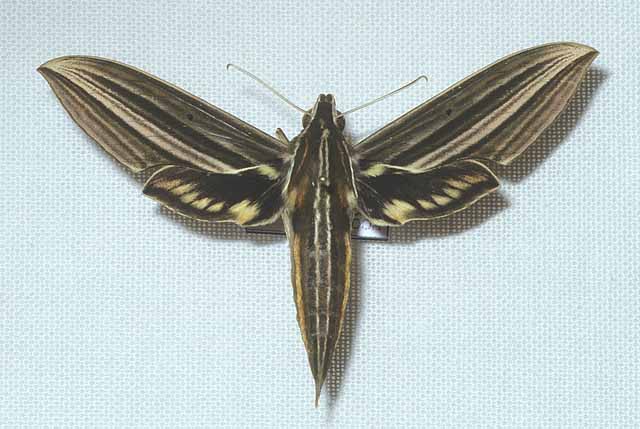
Xylophanes titana male courtesy of Hubert Mayer copyright.
FLIGHT TIMES:
Xylophanes titana adults probably
have at least two flights annually. In Costa Rica moths are taken in all months except March. Larry Valentine reports a
December flight in southern Minas Gerais, Brazil.
Sergio Rios Diaz reports an October flight in Paraguay.
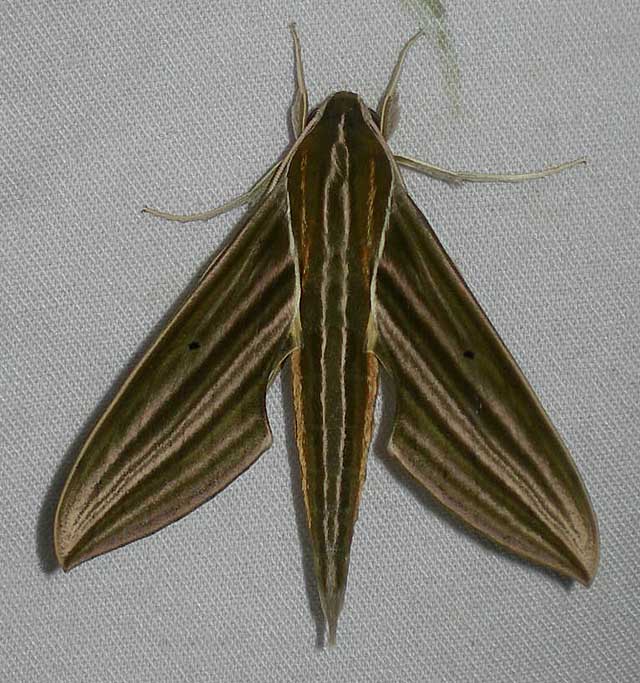
Xylophanes titana, Itanhandu, Minas Gerais, Brazil,
December 11, 2009, courtesy of Larry Valentine.
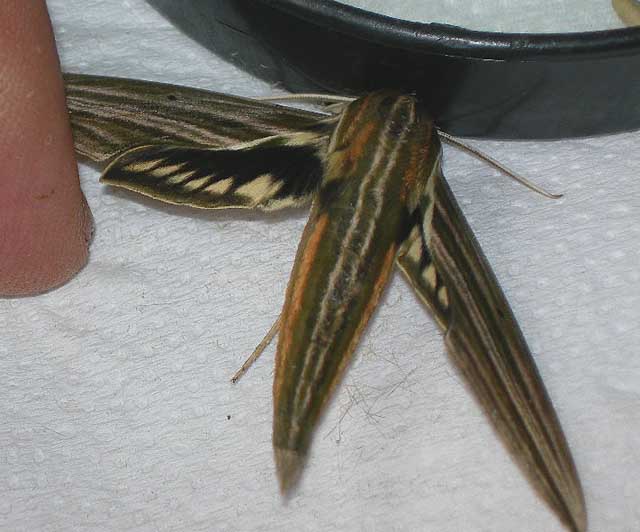
Xylophanes titana, Itanhandu, Minas Gerais, Brazil,
December 11, 2009, courtesy of Larry Valentine.
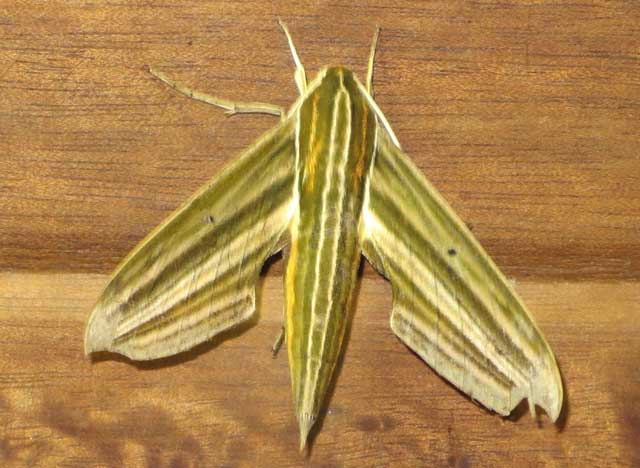
Xylophanes titana, Copalinga Lodge, Podocarpus NP, Zamora-Chinchipe, Ecuador,
February 5, 2014, 1100m, courtesy of Brian Fletcher, id by Bill Oehlke.
ECLOSION:
Pupae probably wiggle to surface from subterranean chambers or leaf litter just prior to eclosion.
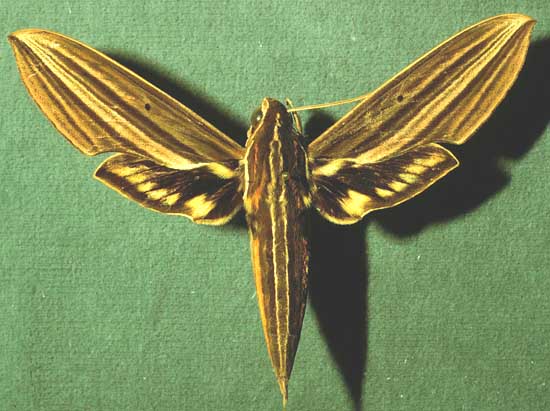
Xylophanes titana female courtesy of Dan Janzen.
SCENTING AND MATING:Females call in the males with a pheromone released from a gland at the tip of the
abdomen. Males come in to lights very readily, but females are seldom taken in that way.

Xylophanes titana, El Copan, Cartago, Costa Rica,
March 6, 2019, 1047m, courtesy of Gernot Kunz.
EGGS, LARVAE, PUPAE:
The snake-like larva has a head and
the three thoracic segments which may be retracted
into abdominal segment 1, which is swollen and adorned with a pair of
light-ringed grey eye-spots.
The eye-spots are situated on a pair of light longitudinal lines,
these lines terminating in a brown caudal horn which is
tightly curved downwards. The dorsal area enclosed by the
longitudinal lines is orange-yellow,
marbled with rusty red, especially towards the head. Ventrally the
larva is purple-brown, with an indication of seven
oblique stripes directed tailward.
Larvae generally feed on Rubiaceae.
In Peru the larva is found on a roadside creeper, possibly
Spermacoce.
In Costa Rica, Dan Janzen reports them on Manettia reclinata.
Moths emerge from pupa in 22-40 days.
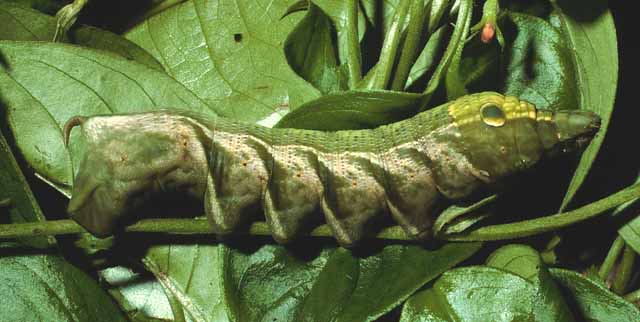
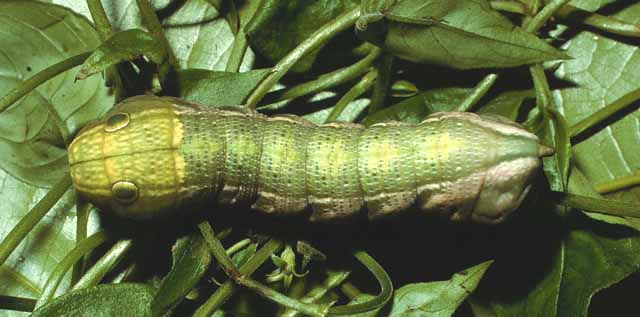
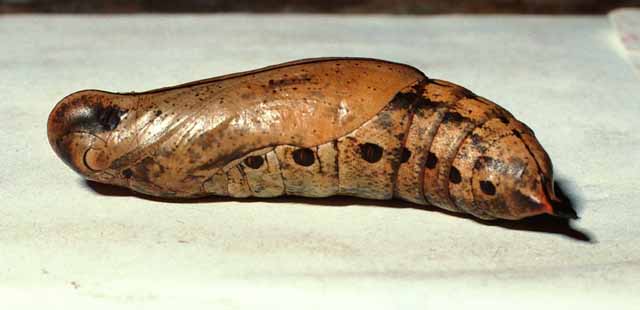
Images courtesy of Dan Janzen.
Use your browser "Back" button to return to the previous page.
Goto Main Sphingidae Index
Goto Macroglossini Tribe
Goto Central American Indices
Goto Carribean Islands
Goto South American Indices
Goto U.S.A. tables
This page is brought to you by Bill Oehlke and the
WLSS. Pages are on space rented from Bizland. If you would like
to become a "Patron of the Sphingidae Site", contact Bill.
Please send sightings/images to Bill. I will do my best to respond to
requests for identification help.
 | 
Show appreciation for this site by clicking on flashing butterfly to the left.
The link will take you to a page with links to many insect sites. |













